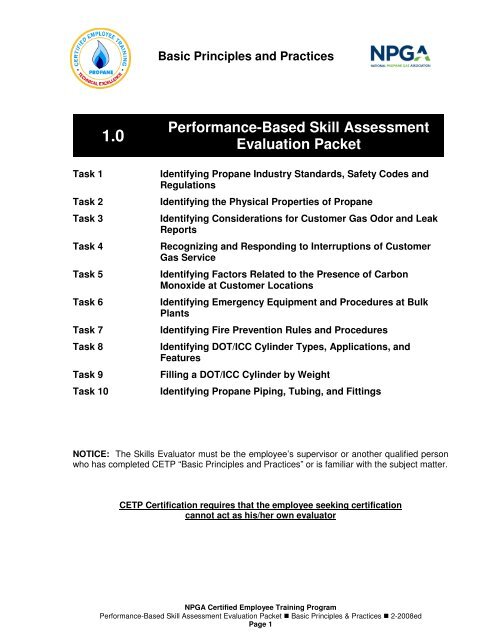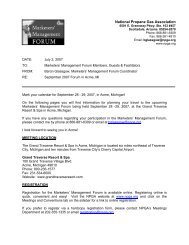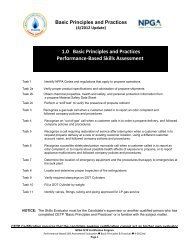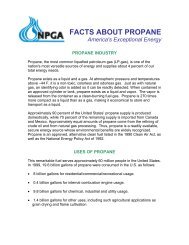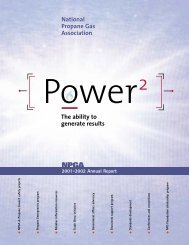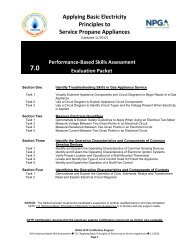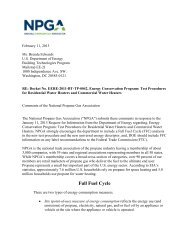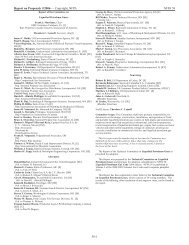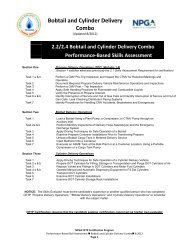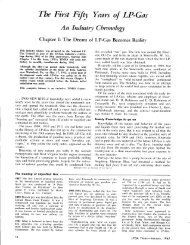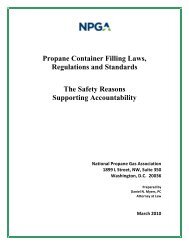Performance-Based Skill Assessment Evaluation Packet - National ...
Performance-Based Skill Assessment Evaluation Packet - National ...
Performance-Based Skill Assessment Evaluation Packet - National ...
Create successful ePaper yourself
Turn your PDF publications into a flip-book with our unique Google optimized e-Paper software.
Basic Principles and Practices<br />
Task 1<br />
Task 2<br />
Task 3<br />
Task 4<br />
Task 5<br />
Task 6<br />
Task 7<br />
Task 8<br />
Task 9<br />
Task 10<br />
1.0<br />
<strong>Performance</strong>-<strong>Based</strong> <strong>Skill</strong> <strong>Assessment</strong><br />
<strong>Evaluation</strong> <strong>Packet</strong><br />
Identifying Propane Industry Standards, Safety Codes and<br />
Regulations<br />
Identifying the Physical Properties of Propane<br />
Identifying Considerations for Customer Gas Odor and Leak<br />
Reports<br />
Recognizing and Responding to Interruptions of Customer<br />
Gas Service<br />
Identifying Factors Related to the Presence of Carbon<br />
Monoxide at Customer Locations<br />
Identifying Emergency Equipment and Procedures at Bulk<br />
Plants<br />
Identifying Fire Prevention Rules and Procedures<br />
Identifying DOT/ICC Cylinder Types, Applications, and<br />
Features<br />
Filling a DOT/ICC Cylinder by Weight<br />
Identifying Propane Piping, Tubing, and Fittings<br />
NOTICE: The <strong>Skill</strong>s Evaluator must be the employee’s supervisor or another qualified person<br />
who has completed CETP “Basic Principles and Practices” or is familiar with the subject matter.<br />
CETP Certification requires that the employee seeking certification<br />
cannot act as his/her own evaluator<br />
NPGA Certified Employee Training Program<br />
<strong>Performance</strong>-<strong>Based</strong> <strong>Skill</strong> <strong>Assessment</strong> <strong>Evaluation</strong> <strong>Packet</strong> Basic Principles & Practices 2-2008ed<br />
Page 1
Table of Contents<br />
I General Instructions ................................................................................................... 3<br />
Instructions for Use .............................................................................................. 3<br />
Instructions to the Employee ................................................................................ 3<br />
Instructions to the <strong>Skill</strong>s Evaluator ....................................................................... 4<br />
II Task Information ........................................................................................................ 5<br />
III Employee <strong>Performance</strong> Checklist ........................................................................... 5<br />
IV CETP <strong>Performance</strong> <strong>Evaluation</strong> / Employee Record ............................................ 14<br />
Users of this material should consult the law of their individual jurisdictions for codes, standards and<br />
legal requirements applicable to them. This material is not intended to be an exhaustive treatment of the<br />
subject, and should not be interpreted as precluding other procedures that would enhance safe LP-gas<br />
operations. This training material merely suggests methods the user may find useful in implementing<br />
applicable codes, standards, and legal requirements. This publication is not intended nor should it be<br />
construed to (1) set forth procedures which are the general custom or practice in the propane industry;<br />
(2) to establish the legal standards of care owed by propane distributors to their customers; or (3) to<br />
prevent the reader from using different methods to implement applicable codes, standards or legal<br />
requirements. This material was designed to be used as a resource only to assist expert and<br />
experienced supervisors and managers in training personnel in their organizations and does not replace<br />
federal, state, local, or company safety rules. The user of this material is solely responsible for the<br />
method of implementation. The Propane Education and Research Council, the <strong>National</strong> Propane Gas<br />
Association, CASTLE Worldwide and Industrial Training Services, Inc. assume no liability for reliance on<br />
the contents of this training material.<br />
Issuance of this material is not intended to nor should it be construed as an undertaking to perform<br />
services on behalf of any party either for their protection or for the protection of third parties.<br />
NPGA Certified Employee Training Program<br />
<strong>Performance</strong>-<strong>Based</strong> <strong>Skill</strong> <strong>Assessment</strong> <strong>Evaluation</strong> <strong>Packet</strong> Basic Principles & Practices 2-2008ed<br />
Page 2
I. General Instructions<br />
Instructions for Use<br />
This <strong>Performance</strong> <strong>Based</strong> <strong>Skill</strong> <strong>Assessment</strong> <strong>Evaluation</strong> <strong>Packet</strong> is designed to:<br />
• Provide structured on-the-job training for the LP-Gas employee under the direction of an<br />
experienced and qualified skills evaluator, and<br />
• Standardize conditions under which the employee demonstrates his/her performance of<br />
tasks that meet the requirements of the NPGA Certified Employee Training Program.<br />
Each task is divided into one or more operations on which the employee’s performance is<br />
evaluated. Each operation is designated by the box symbol (). Also, under each operation<br />
is a performance guide that establishes the standard used by the skills evaluator.<br />
When an operation within a task is successfully performed by the employee according to the<br />
criteria listed in the performance guide, a check () is placed in the box ().<br />
For employee certification, Section IV: CETP <strong>Performance</strong> <strong>Evaluation</strong> / Employee Record<br />
must be received at the appropriate testing center below within 12 months of passing<br />
the certification exam. Make a copy for the training records and then send the original<br />
to:<br />
On-line Test Candidates:<br />
Paper test Candidates:<br />
CASTLE Worldwide<br />
Industrial Training Services, Inc.<br />
P.O. Box 570<br />
310 CC Lowry Drive<br />
Morrisville, NC 27560 Murray, KY 42071<br />
Ph: 919-572-6880 Ph: 270-753-2150 ext 2<br />
Fax: 919-361-2426 Fax: 270-753-9807<br />
Instructions to the Employee<br />
The performance based <strong>Skill</strong> <strong>Assessment</strong> <strong>Evaluation</strong> <strong>Packet</strong> is designed as a training guide to<br />
assist you and your evaluator in performing the tasks listed on the front cover. Practice the<br />
tasks as many times as needed to become confident and proficient with the documents or<br />
equipment. Your skills evaluator will check and observe your performance using the checklist<br />
included in each hands-on task assignment.<br />
The employee must adhere to all safety precautions. If a safety precaution is violated, then the<br />
demonstration shall be stopped and the skills evaluator must instruct the employee on the<br />
proper safety procedures that apply before allowing the employee to continue.<br />
The packet is designed to establish the basic conditions under which the employee<br />
demonstrated his/her level of knowledge and proficiency.<br />
NPGA Certified Employee Training Program<br />
<strong>Performance</strong>-<strong>Based</strong> <strong>Skill</strong> <strong>Assessment</strong> <strong>Evaluation</strong> <strong>Packet</strong> Basic Principles & Practices 2-2008ed<br />
Page 3
Instructions to the <strong>Skill</strong>s Evaluator<br />
Review Section II, “Task Information."<br />
Conduct the training as follows:<br />
• Give a copy of the <strong>Performance</strong> <strong>Based</strong> <strong>Skill</strong> <strong>Assessment</strong> <strong>Evaluation</strong> <strong>Packet</strong> to the<br />
employee.<br />
• Review all of the instructions with the employee and answer any questions or concerns<br />
about how it will be used.<br />
• Demonstrate and/or talk the employee through each of the steps required to do the task.<br />
• Allow the employee time to ask questions and/or study the steps.<br />
• Observe the employee performing the required steps; correct him/her as needed.<br />
• Allow the employee to practice until he/she is confident.<br />
• Evaluate the employee at his/her request.<br />
• Complete Section III, “Employee <strong>Performance</strong> Checklist.”<br />
• After completing the checklist for those operations required in the employee’s job duties,<br />
the skills evaluator and employee must sign their respective affidavits.<br />
For employee certification, Section IV: CETP <strong>Performance</strong> <strong>Evaluation</strong> / Employee Record must be<br />
received at the appropriate testing center below within 12 months of passing the certification<br />
exam. Make a copy for the training records and then send the original to:<br />
On-line Test Candidates:<br />
Paper test Candidates:<br />
CASTLE Worldwide<br />
Industrial Training Services, Inc.<br />
P.O. Box 570<br />
310 CC Lowry Drive<br />
Morrisville, NC 27560 Murray, KY 42071<br />
Ph: 919-572-6880 Ph: 270-753-2150 ext 2<br />
Fax: 919-361-2426 Fax: 270-753-9807<br />
NPGA Certified Employee Training Program<br />
<strong>Performance</strong>-<strong>Based</strong> <strong>Skill</strong> <strong>Assessment</strong> <strong>Evaluation</strong> <strong>Packet</strong> Basic Principles & Practices 2-2008ed<br />
Page 4
II. Task Information<br />
Certification Standard: The employee's certification is based on satisfactory completion of<br />
the operations listed under each task in the <strong>Performance</strong>-<strong>Based</strong><br />
<strong>Skill</strong> <strong>Assessment</strong> <strong>Evaluation</strong> <strong>Packet</strong>.<br />
Prerequisites:<br />
The granting of CETP Certification for this area of study is based on<br />
the Candidate successfully completing the following prerequisites:<br />
• Passing exam score on CETP Certification 1.0 “Basic Principles and<br />
Practices”<br />
• Completed and signed “1.0 Basic Principles and Practices” <strong>Skill</strong>s<br />
<strong>Assessment</strong> is received at the appropriate testing center within 12<br />
months of passing exam (ITS or CASTLE Worldwide).<br />
References:<br />
<strong>Evaluation</strong>:<br />
Applicable LP-Gas Codes and company policies.<br />
The skills evaluator must be the employee’s supervisor or another<br />
qualified person who has completed CETP 1.0 “Basic Principles and<br />
Practices” or is familiar with the subject matter.<br />
CETP certification requires that the employee seeking certification<br />
cannot act as his/her own evaluator<br />
NPGA Certified Employee Training Program<br />
<strong>Performance</strong>-<strong>Based</strong> <strong>Skill</strong> <strong>Assessment</strong> <strong>Evaluation</strong> <strong>Packet</strong> Basic Principles & Practices 2-2008ed<br />
Page 5
III. Employee <strong>Performance</strong> Checklist<br />
Task 1<br />
Identifying Propane Industry Standards, Safety Codes and Regulations<br />
The employee is qualified to perform Task 1 at the following level:<br />
Satisfactory<br />
<br />
Identified NFPA Codes and regulations that apply to propane<br />
operations. (CETP Manual: Module 1.1.1)<br />
<strong>Performance</strong> Guide: Using copies of NFPA 54, NFPA 58 and the Code of Federal<br />
Regulations and other regulatory codes available at the workplace, the employee<br />
being evaluated for certification:<br />
1. Located and read aloud the Scope of NFPA 58 as found in Chapter 1 of the LP-<br />
Gas Code.<br />
2. Located and read aloud the Scope of NFPA 54 as found in Chapter 1 of the<br />
<strong>National</strong> Fuel-Gas Code.<br />
3. Located any applicable state or local codes and determined if NFPA 54 and 58<br />
are adopted, modified or reference by state and/or local codes.<br />
4. Located any portion of the Code of Federal Regulations and found a section<br />
that applies to propane or LP-gas operations.<br />
NPGA Certified Employee Training Program<br />
<strong>Performance</strong>-<strong>Based</strong> <strong>Skill</strong> <strong>Assessment</strong> <strong>Evaluation</strong> <strong>Packet</strong> Basic Principles & Practices 2-2008ed<br />
Page 6
Task 2<br />
Identifying the Physical Properties of Propane<br />
The employee is qualified to perform Task 2 at the following level:<br />
Satisfactory<br />
<br />
Document Used: Actual Propane Shipment Bill of Lading<br />
Facsimile Bill of Lading Included with Checklist<br />
Verify Proper Product Specifications and Odorization of<br />
Propane Shipments. (CETP Manual: Modules 1.3.2, 1.4.1)<br />
<strong>Performance</strong> Guide: The person being evaluated for certification:<br />
1. Obtained a propane shipment bill of lading and any attached shipping<br />
documents for a shipment received at a company bulk plant. (If an<br />
actual bill of lading was not available, the employee used the facsimile<br />
bill of lading included in this Employee Certification packet.)<br />
2. On the bill of lading, placed a check () next to the product name;<br />
3. Circled the quantity of ethyl mercaptan added to the propane;<br />
4. Underlined the number of net gallons shipped;<br />
5. Underlined the specific gravity of the product;<br />
6. Circled the vapor pressure of the product at 100°F;<br />
7. Determined that the specific gravity shown on the bill of lading was<br />
within a range of 0.006 ± (plus or minus) of the approximate specific<br />
gravity given for Commercial Propane in Table B.1.2(a), found in<br />
Annex B to NFPA 58, 2008 edition;<br />
8. Determined that the amount of ethyl mercaptan added for the net<br />
gallons shipped was equal to or greater than the amounts shown in the<br />
chart below;<br />
9. Listed the actions required by company procedures if product<br />
specifications or odorization is not properly documented.<br />
NPGA Certified Employee Training Program<br />
<strong>Performance</strong>-<strong>Based</strong> <strong>Skill</strong> <strong>Assessment</strong> <strong>Evaluation</strong> <strong>Packet</strong> Basic Principles & Practices 2-2008ed<br />
Page 7
Task 2<br />
Indentifying the Physical Properties of Propane (continued)<br />
If an actual bill of lading is not available at the employee’s work place the following facsimile bill<br />
of lading may be used for Task 2:<br />
NPGA Certified Employee Training Program<br />
<strong>Performance</strong>-<strong>Based</strong> <strong>Skill</strong> <strong>Assessment</strong> <strong>Evaluation</strong> <strong>Packet</strong> Basic Principles & Practices 2-2008ed<br />
Page 8
Task 2<br />
Indentifying the Physical Properties of Propane (continued)<br />
Satisfactory<br />
<br />
Obtained chemical properties, health and safety, and personal<br />
protection information from a propane Material Safety Data<br />
Sheet. (CETP Manual: Module 1.3.3, and the Resources Section)<br />
<strong>Performance</strong> Guide: The employee being evaluated for certification:<br />
1. Obtained a propane MSDS from the work place Hazard Communication<br />
Program records.<br />
2. Located the Chemical Abstract Service (CAS) number for propane.<br />
3. Located the section of the MSDS that lists the hazards associated with<br />
propane, including each of the NFPA 704 hazard values from 0 to 4 for<br />
propane’s health, flammability and reactivity hazards.<br />
4. Read aloud the section of the MSDS detailing health effects of:<br />
Inhalation<br />
Eye Contact<br />
Skin Contact<br />
Other health effects<br />
5. Located and read aloud the section of the MSDS detailing First Aid Measures<br />
for exposure to propane.<br />
6. Located and read aloud the section related to Fire-Fighting Measures that apply<br />
to propane.<br />
7. Located and read aloud the sections related to Accidental Release and<br />
Handling and Storage of propane.<br />
8. Located and read aloud the section related to Exposure Controls and/or<br />
Personal Protection. The employee identified recommended personal<br />
protective equipment (PPE) for use in propane operations.<br />
9. Located and identified to the evaluator the MSDS section which lists propane’s<br />
physical and chemical properties.<br />
10. The employee read aloud any other section titles in the MSDS, such as<br />
Transportation Information or Regulatory Information and stated to the<br />
evaluator how the information is used on the job.<br />
Satisfactory<br />
<br />
Not<br />
Applicable*<br />
<br />
Performed a “sniff test” to verify the presence of propane<br />
odorant. (CETP Manual: Module 1.4.1)<br />
<strong>Performance</strong> Guide: The employee being evaluated for certification:<br />
1. Wore protective gloves, safety glasses or other PPE as required by company<br />
safety procedures.<br />
2. Vented a small quantity of propane through a #54 drill size opening at the plant<br />
dispenser unit, fill dock or transfer bulkhead.<br />
3. Quickly closed the vent valve or outage fitting.<br />
4. Sniffed the vaporized propane to determine if odorant was readily perceived.<br />
5. Documented the sniff test on appropriate company forms<br />
*Not applicable means that this person’s job description does not require the person<br />
to perform an odorant sniff test in the course of his/her duties.<br />
NPGA Certified Employee Training Program<br />
<strong>Performance</strong>-<strong>Based</strong> <strong>Skill</strong> <strong>Assessment</strong> <strong>Evaluation</strong> <strong>Packet</strong> Basic Principles & Practices 2-2008ed<br />
Page 9
Task 3<br />
Identifying Considerations for Customer Gas Odor and Leak Reports<br />
The employee is qualified to perform Task 3 at the following level:<br />
Satisfactory<br />
<br />
Recognized a gas leak call when a customer called in to report<br />
an odor complaint, and followed company policies and<br />
procedures. (CETP Manual: Module 1.4.2)<br />
Evaluator note: Customer calls used in this skill performance evaluation may be<br />
actual calls or simulated customer calls.<br />
<strong>Performance</strong> Guide: The employee being evaluated for certification:<br />
1. Informed the customer or caller of company procedures for handling odor/gas<br />
leak calls and communicated any company customer warnings or cautionary<br />
statements to the caller, and specifically directed the customer to evacuate the<br />
building and to keep unqualified persons out of the structure.<br />
2. Correctly identified the service call as an odor/gas leak call on designated<br />
company dispatch records.<br />
3. Dispatched designated service/delivery personnel and clearly communicated<br />
that the service call is a priority service call/reported gas leak.<br />
4. Properly completed any company documentation required to record the<br />
disposition of the odor/leak call, and results of the odor/leak investigation,<br />
system leak checks and any gas system repairs made.<br />
Task 4<br />
Recognizing and Responding to Interruptions of Customer Gas Service<br />
The employee is qualified to perform Task 4 at the following level:<br />
Satisfactory<br />
<br />
Recognized an “out-of-gas” call when a customer called in to<br />
order a propane delivery, and followed company policies and<br />
procedures. (CETP Manual: Module 1.4.2)<br />
Evaluator note: Customer calls used in this skill performance evaluation may be<br />
actual calls or simulated customer calls.<br />
<strong>Performance</strong> Guide: The employee being evaluated for certification:<br />
1. Informed the customer or caller of company procedures for handling “out-ofgas”<br />
calls and communicated any company customer warnings or cautionary<br />
statements to the caller.<br />
2. Correctly identified the delivery as an “out-of-gas” call on designated company<br />
dispatch records.<br />
3. Dispatched designated service/delivery personnel and clearly communicated<br />
that the service call is an out-of-gas service call.<br />
4. Properly completed any company documentation required to record the<br />
disposition of the out-of-gas call, and/or efforts to minimize out-of-gas<br />
occurrences in the future.<br />
Continued on the next<br />
page<br />
NPGA Certified Employee Training Program<br />
<strong>Performance</strong>-<strong>Based</strong> <strong>Skill</strong> <strong>Assessment</strong> <strong>Evaluation</strong> <strong>Packet</strong> Basic Principles & Practices 2-2008ed<br />
Page 10
Task 4<br />
Recognizing and Responding to Interruptions of Customer Gas Service (cont.)<br />
Satisfactory<br />
<br />
Recognized a call requiring restoration of service after<br />
interruption of gas service when a customer called in to request<br />
propane delivery at a new or existing customer location, using a<br />
different customer account name, and following company<br />
policies and procedures. (CETP Manual: Module 1.4.2)<br />
<strong>Performance</strong> Guide: The employee being evaluated for certification:<br />
1. Informed the customer or caller of company procedures for handling interruption<br />
or new service calls and communicated any company GAS Check® or other<br />
system inspection services that apply.<br />
2. Correctly identified the service call as a new service or interruption of service<br />
call on designated company dispatch records.<br />
3. Dispatched qualified delivery/service personnel and clearly communicated that<br />
the service call is a new service call or interruption of service call.<br />
4. Properly completed any documentation required to record the disposition of the<br />
GAS Check® or other system inspection services and any repairs or system<br />
information records needed according to company policies and procedures.<br />
Task 5<br />
Identifying Factors Related to the Presence of Carbon Monoxide at Customer<br />
Locations<br />
The employee is qualified to perform Task 5 at the following level:<br />
Satisfactory<br />
<br />
Recognized a possible aldehydes/carbon monoxide call when a<br />
customer called in to report an odor complaint or to inquire<br />
about possible health effects of exposure to propane or to<br />
report appliance malfunctions, and followed company policies<br />
and procedures. (CETP Manual: Module 1.5.3)<br />
Evaluator note: Customer calls used in this skill performance evaluation may be<br />
actual calls or simulated customer calls.<br />
<strong>Performance</strong> Guide: The employee being evaluated for certification:<br />
1. Informed the customer or caller of company procedures for handling odor report<br />
calls and communicated any company customer warnings or cautionary<br />
statements to the caller.<br />
2. Correctly identified the service call as an odor/possible CO call on designated<br />
company dispatch records.<br />
3. Dispatched qualified odor/CO response personnel and clearly communicated<br />
that the service call is a priority service call/odor or possible carbon monoxide<br />
report, along with all other customer reported conditions.<br />
4. Properly completed any company documentation required to record the<br />
disposition of the odor/possible CO service call, and results of the odor/CO<br />
investigation, system leak checks and any gas system venting/ventilation<br />
system inspections and checks, appliance defects found and repaired, if any. If<br />
the CO investigation was done by others, such as a fire department or Heating,<br />
Ventilation, Air Conditioning (HVAC) contractor, documented the investigation<br />
by recording who conducted the investigation, the time, date and results of the<br />
investigation.<br />
NPGA Certified Employee Training Program<br />
<strong>Performance</strong>-<strong>Based</strong> <strong>Skill</strong> <strong>Assessment</strong> <strong>Evaluation</strong> <strong>Packet</strong> Basic Principles & Practices 2-2008ed<br />
Page 11
Task 6<br />
Identifying Emergency Equipment and Procedures Used at Bulk Plants<br />
The employee is qualified to perform Task 6 at the following level:<br />
Satisfactory<br />
<br />
Determined the location of emergency shut-off valves and the<br />
procedures that apply to emergencies in the bulk plant.<br />
(CETP Manual: Modules 1.6.1, 1.6.2, and 1.7.1)<br />
<strong>Performance</strong> Guide: The employee being evaluated for certification:<br />
1. Obtained a copy of the company emergency response plan for the bulk plant.<br />
2. Identified the notification procedures given in the plan as they apply to:<br />
Notifying emergency response agencies;<br />
Notifying company personnel and management.<br />
3. Identified site evacuation procedures and designated off-site gathering places<br />
for company personnel.<br />
4. Identified the location of key plant emergency control features, including:<br />
Remote emergency shutdown stations and ESV controls;<br />
Bulkhead ESV locations;<br />
Railcar Riser ESV locations (if applicable);<br />
Bulk storage tank and piping primary shutoff valves;<br />
Dispenser unit and/or filling dock storage tank and piping primary shutoff<br />
valves.<br />
Main electrical disconnect.<br />
5. Identified exit routes from buildings and work areas in the bulk plant, and the<br />
location of fire extinguishers and other safety equipment located along the exit<br />
routes.<br />
6. Identified the best exit route to follow from the employee’s primary workstation,<br />
accounting for wind direction.<br />
7. Stated ignition source control measures that apply in emergencies.<br />
Task 7<br />
Identifying Fire Prevention Rules and Procedures<br />
The employee is qualified to perform Task 7 at the following level:<br />
Satisfactory<br />
<br />
Located and determined proper inspection of fire extinguishers.<br />
(CETP Manual: Module 1.6.3)<br />
<strong>Performance</strong> Guide: On a DOT cylinder, the employee being evaluated for<br />
certification:<br />
1. Located fire extinguisher stations in the shop/warehouse area and determined if<br />
extinguisher inspections were current.<br />
2. Read aloud the extinguisher manufacturer’s instruction for use.<br />
NPGA Certified Employee Training Program<br />
<strong>Performance</strong>-<strong>Based</strong> <strong>Skill</strong> <strong>Assessment</strong> <strong>Evaluation</strong> <strong>Packet</strong> Basic Principles & Practices 2-2008ed<br />
Page 12
Task 8<br />
Identifying ICC/DOT Cylinder Types, Applications, and Features<br />
The employee is qualified to perform Task 8 at the following level:<br />
Satisfactory<br />
<br />
Verified required stampings on DOT cylinders.<br />
(CETP Manual: Module 1.8.2)<br />
<strong>Performance</strong> Guide: On a DOT cylinder, the employee being evaluated for<br />
certification:<br />
1. Located the marking that indicates the empty weight of the cylinder.<br />
2. Verified that the cylinder is stamped with one of the following DOT or ICC<br />
specifications<br />
4B-240 4BA-240 4BW-240<br />
4E-240 26-240.<br />
3. Verified that the cylinder is properly marked with tare weight, water capacity,<br />
serial number, manufacturer or trade name, dip tube length, and registered<br />
tester’s symbol.<br />
4. Located the original cylinder test date stamping and any subsequent requalification<br />
dates to verify that the day the cylinder is inspected is within 12<br />
years of the cylinder’s original test date, or within 5 years of the latest month<br />
and date followed by the letter E stamped on the cylinder, or within 7 years of<br />
the latest month and year followed by the letter S.<br />
5. Located the cylinder service valve. The employee pointed out the relief valve,<br />
and the direction that any gas relieved under pressure would be vented from<br />
the cylinder.<br />
Task 9<br />
Filling a DOT Cylinder by Weight<br />
The employee is qualified to perform Task 9 at the following level:<br />
Satisfactory<br />
<br />
Not<br />
Applicable*<br />
<br />
*Not applicable means that<br />
the person’s job description<br />
does not include any duty<br />
such as filling a DOT<br />
cylinder by weight.<br />
Filled a DOT cylinder by weight. (CETP Manual: Module 1.8.2)<br />
<strong>Performance</strong> Guide: At a dispenser or bulk plant and wearing company-required<br />
personal protective equipment, the employee being evaluated for certification:<br />
1. Verified that the dispensing equipment was in good working order and met<br />
NFPA 58 requirements.<br />
2. Opened the liquid outlet valve on storage tank and valves in the by-pass return<br />
line.<br />
3. Verified by visual inspection of the outside of the cylinder that the cylinder was<br />
fit for propane service and filling.<br />
4. Placed scales index at the proper setting, equal to the tare weight of the<br />
cylinder plus the weight of propane (cylinder water capacity times 0.42) plus the<br />
weight of the transfer hose, hose-end valve and adapter(s).<br />
5. Connected the hose to cylinder fill valve.<br />
6. Opened the hose-end valve.<br />
7. Opened the valve on the cylinder.<br />
8. Started the pump.<br />
9. Closed the hose-end valve as soon as scale beam or indicator tipped.<br />
10. Shut off the pump.<br />
11. Closed the cylinder valve.<br />
12. Disconnected the hose.<br />
13. Checked the weight of filled cylinder after the filling connector was<br />
disconnected. If overfilled, bleed off excess propane in a safe location.<br />
14. Checked the cylinder service valve and relief valve for leaks.<br />
15. Installed a POL plug on cylinders 45 lbs. or less propane capacity not equipped<br />
with a quick closing connection or adapter.<br />
16. Applied a DOT shipping label if one was not already in place and/or cylinder<br />
warning label if the manufacturer’s label is not legible, or any other consumer or<br />
commercial customer warning label required by company procedures.<br />
NPGA Certified Employee Training Program<br />
<strong>Performance</strong>-<strong>Based</strong> <strong>Skill</strong> <strong>Assessment</strong> <strong>Evaluation</strong> <strong>Packet</strong> Basic Principles & Practices 2-2008ed<br />
Page 13
Task 10<br />
Identifying Propane Piping, Tubing, and Fittings<br />
The employee is qualified to perform Task 10 at the following level:<br />
Satisfactory<br />
<br />
Not<br />
Applicable*<br />
<br />
Identify valves, fittings, tubing and piping approved for LP-gas<br />
service. (CETP Manual: Module 1.8.4)<br />
<strong>Performance</strong> Guide: In the shop or warehouse, the employee being evaluated<br />
for certification:<br />
1. Obtained a container service valve, or other service fitting and determined<br />
which of the following manufacturing standards applied to the valve or fitting:<br />
UL<br />
ASTM<br />
2 Obtained a section of polyethylene pipe or tubing or a section of corrugated s<br />
stainless steel tubing and determined which of the following manufacturing<br />
standards applied to the pipe or tubing:<br />
UL<br />
ASTM<br />
3. Determined from shipping cartons or coil covers whether copper tubing stored<br />
in the shop or warehouse is Type L or Type K or Type R.<br />
4. Obtained steel pipe nipples from the shop or warehouse inventories and<br />
determined whether the pipe nipples were schedule 40 or schedule 80.<br />
5. Correctly identified whether threaded schedule 40 piping can be used to<br />
contain propane in a liquid state and/or at unregulated tank pressure.<br />
*Not applicable means that this person’s workplace does not have any of<br />
the materials needed for this performance evaluation, and the person’s job<br />
description does not include any duty such as installation or inventory<br />
control (ordering, receiving, storing or classifying for inventory purposes)<br />
that requires the employee to verify that installation materials or container<br />
fittings are approved for propane service.<br />
NPGA Certified Employee Training Program<br />
<strong>Performance</strong>-<strong>Based</strong> <strong>Skill</strong> <strong>Assessment</strong> <strong>Evaluation</strong> <strong>Packet</strong> Basic Principles & Practices 2-2008ed<br />
Page 14
Section IV: CETP <strong>Performance</strong> <strong>Evaluation</strong> / Employer Record (1.0)<br />
For employee certification, Section IV: CETP <strong>Performance</strong> <strong>Evaluation</strong> / Employee Record must be<br />
received at the appropriate testing center below within 12 months of passing the certification<br />
exam. Make a copy for your records and then send the original to:<br />
On-line Test Candidates:<br />
Paper Test Candidates:<br />
CASTLE Worldwide<br />
Industrial Training Services, Inc.<br />
P.O. Box 570<br />
310 CC Lowry Drive<br />
Morrisville, NC 27560 Murray, KY 42071<br />
Ph: 919-572-6880 Ph: 270-753-2150 ext. 2<br />
Fax: 919-361-2426 Fax: 270-753-9807<br />
The information requested below will be used to assist in locating your records in the CETP database.<br />
Please make sure to complete all requested information; we thank you in advance for your assistance.<br />
Employee Information: (print or type) Test Group Number (if known): ________________________<br />
Last Four Digits (only) of<br />
Name ___________________________________ Social Security Number _____________<br />
Employer ____________________________________________________________________<br />
Address __________________________________Daytime Phone# _____________________<br />
City, State: _______________________________________ Zip Code _________________<br />
Affidavit<br />
I affirm that I am the person who has performed those items checked on this checklist. I acknowledge<br />
that the performance checklists used are solely for the purpose of skills assessment for the CETP<br />
certification requirements, and are not intended to replace or modify company operating or safety<br />
procedures, and may not be appropriate for use in all circumstances. I acknowledge that I am<br />
responsible for recognizing hazards and abnormal conditions in my workplace and must exercise care<br />
and good judgment, always using appropriate equipment, procedures and tools for the tasks I perform.<br />
The Propane Education and Research Council, the <strong>National</strong> Propane Gas Association, CASTLE<br />
Worldwide and Industrial Training Services, Inc. assume no liability for my actions, or for my application<br />
of the skills assessment performance guides used in this evaluation checklist.<br />
Employee’s Signature_____________________________ Date_________________<br />
<strong>Skill</strong>s Evaluator Information: (print or type)<br />
Name ________________________________________________________________<br />
Organization/Employer___________________________________________________<br />
Telephone Number______________________________________________________<br />
Affidavit<br />
I affirm that I am the person who has administered this checklist, and that I have conducted this<br />
employee skills assessment with integrity. I also affirm that the above named employee is the person<br />
whose performance I evaluated, and that the above named person performed the checked tasks at the<br />
indicated level without assistance from me or any other person.<br />
<strong>Skill</strong> Evaluator’s Signature_______________________________ Date __________<br />
• Send this Section to your testing center •<br />
NPGA Certified Employee Training Program<br />
<strong>Performance</strong>-<strong>Based</strong> <strong>Skill</strong> <strong>Assessment</strong> <strong>Evaluation</strong> <strong>Packet</strong> Basic Principles & Practices 2-2008ed<br />
Page 15
Last Four Digits (only) of<br />
Name ______________________________________ Social Security Number ________<br />
The employee is qualified to perform the listed operations at the following level:<br />
Satisfactory<br />
<br />
<br />
<br />
Identified NFPA Codes and regulations that apply to propane<br />
operations. (Task 1 - CETP Manual: Module 1.1.1)<br />
Verify proper product specifications and odorization of propane<br />
shipments. (Task 2 – CETP Manual: Module 1.3.2, 1.4.1)<br />
Obtained chemical properties, health and safety, and personal<br />
protection information from a propane Material Safety Data Sheet.<br />
(Task 2 - CETP Manual: Module 1.3.3, Resources)<br />
Performed a “sniff test” to verify the presence of propane odorant.<br />
(Task 2 - CETP Manual: Module 1.4.1)<br />
<br />
<br />
<br />
<br />
<br />
<br />
<br />
Not<br />
Applicable<br />
Recognized a gas leak call when a customer called in to report an odor<br />
complaint, and followed company policies and procedures.<br />
(Task 3 - CETP Manual: Module 1.4.2)<br />
Recognized an “out-of-gas” call when a customer called in to order a<br />
propane delivery, and followed company policies and procedures.<br />
(Task 4 - CETP Manual: Module 1.4.2)<br />
Recognized a call requiring restoration of service after interruption<br />
when a customer called in to request propane delivery at a new or<br />
existing customer location, using a different customer account name,<br />
and following company policies and procedures.<br />
(Task 4 - CETP Manual: Module 1.4.2)<br />
Recognized a possible aldehydes/carbon monoxide call when a<br />
customer called in to report an odor complaint or to inquire about<br />
possible health effects of exposure to propane or to report appliance<br />
malfunctions, and followed company policies and procedures.<br />
(Task 5 – CETP Manual: Module 1.5.3)<br />
Determined the location of emergency equipment and the procedures<br />
that apply to emergencies in the bulk plant.<br />
(Task 6 - CETP<br />
Manual: Modules 1.6.1, 1.6.2, and 1.7.1)<br />
Located and determined proper inspection of fire extinguishers<br />
(Task 7 – CETP Manual: Module 1.6.3)<br />
Verified required stampings on DOT cylinders<br />
(Task 8: CETP Manual: Module 1.8.2)<br />
Filled a DOT Cylinder by Weight (Task 9: CETP Manual: Module 1.8.2)<br />
Identify valves, fittings, tubing and piping approved for LP-gas service.<br />
(Task 10 - CETP Manual: Module 1.8.4)<br />
For employee certification, Section IV: CETP <strong>Performance</strong> <strong>Evaluation</strong> / Employee Record must be<br />
received at the appropriate testing center below within 12 months of passing the certification<br />
exam. Make a copy for the training records and then send the original to your testing center:<br />
On-line Test Candidates:<br />
Paper Test Candidates:<br />
CASTLE Worldwide<br />
Industrial Training Services, Inc.<br />
P.O. Box 570<br />
310 CC Lowry Drive<br />
Morrisville, NC 27560 Murray, KY 42071<br />
Ph: 919-572-6880 Ph: 270-753-2150 ext 2<br />
Fax: 919-361-2426 Fax: 270-753-9807<br />
• Send this Section to your Testing Center •<br />
NPGA Certified Employee Training Program<br />
<strong>Performance</strong>-<strong>Based</strong> <strong>Skill</strong> <strong>Assessment</strong> <strong>Evaluation</strong> <strong>Packet</strong> Basic Principles & Practices 2-2008ed<br />
Page 16


